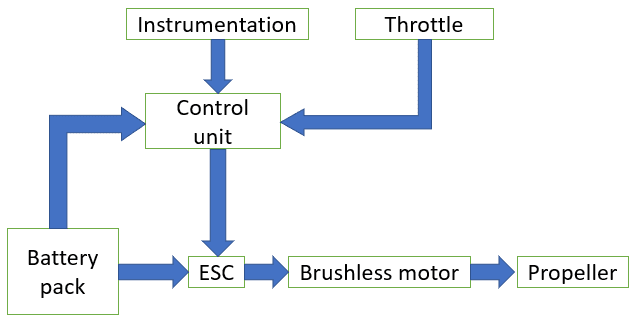Airplanes are one of the biggest fossil fuel consumers in the world. It is necessary to search more sustainable solution to aviation. The electric airplane is this post`s subject.
Electrical propulsion system
Electric motor to airplane propulsion is brushless, it needs an electronic speed control (ESC). This is a 350 HP electric motor of MagniX to electric planes.

The same motor installed in an electric airplane.

Typical flowchart of an electric propulsion system. ESC is controlled by the pilot through an unit control.

Electric airplane`s technical obstacles
Petroleum fuels have an energy density much higher than the best ion batteries.

It means that needs a too big number of batteries to store the same quantity of energy as a much smaller volume of kerosene. Bigger number of batteries will increase weight, as explained in post about aerodynamics, lift force must be equal to weight to keep the airplane in air. Therefore, is necessary bigger speed, which will require more power and battery consumption.
The weight of batteries is more critical to big comercial planes than smaller ones. Airplanes can have solar panels to recharge batteries and increase flight autonomy.

A battery pack needs a cooling system as light as possible. New materials need to be created to have a better thermal dissipation or less heat generation. A possible solution is use superconductors in transmission energy cables and motors, because superconductors have zero resistance to passage of electric current. Therefore, there is no generation of heat by Joule effect, the conversion of electrical energy in thermal when a current pass through a conductor.
Itaipu Binacional’s Electric airplane
Itaipu Binacional and ACS Aviation built a manned electric plane in June, 2015 in São José dos Campos. The Sora-e has been built to study materials to aeronautics, which are light and efficient. When lighter the aircraft, higher autonomy.
 Data and features of Sora-e:
Data and features of Sora-e:
- Two 35 kW Enrax thrusters.
- 6 lithium ion polymer battery packs which provide 400 V.
- Cruise speed of 190 km/h and maximum of 340 km/h.
- One hour and a half of flight autonomy.
- Carbon fiber structure.
- Wingspan, distance from one end of wing to another, is 8 meters.
- Weights 650 kg.



